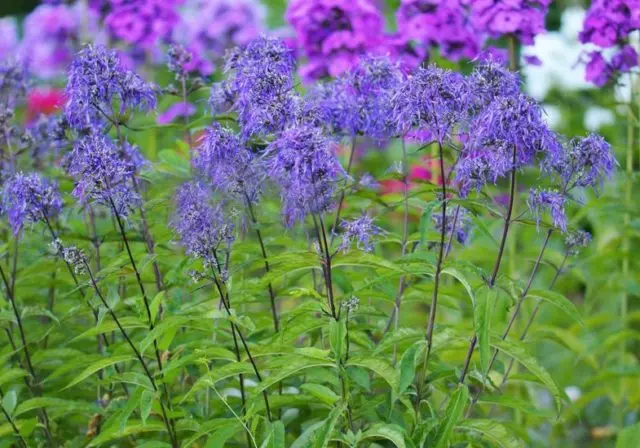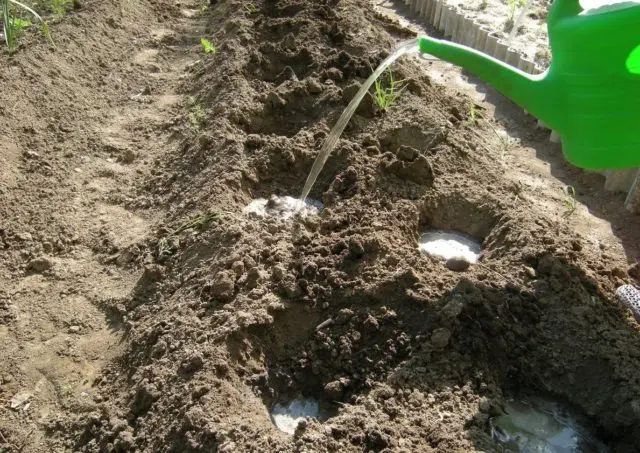Contents
Phlox Genius is an unusual perennial representative of the Sinyukhov family (Polemoniaceae), outwardly resembling a lush carnation flower. The originator of the variety, bred in 2017, is the breeder V.A. Maslov. Flowers are used in ornamental gardening. They are harmoniously combined with other cultures, so they can be found in various flowerbed plantings.
Description of panicled phlox Genius
Panicled phlox Genius is a herbaceous bush culture that grows up to 60-90 cm in height. The bush is medium spreading, its diameter does not exceed 40 cm.
The leaves are light green, oblong, pointed at the ends, slightly curved.
The plant is intended for cultivation in an open ground. Phlox frost resistance zone Genius – 4, i.e. it can withstand temperatures down to -35 ° C. It can be cultivated in the Moscow region and in other regions of Our Country with a temperate climate, including the northern and mountainous territories.
Genius is a light-loving variety that grows well in areas with periodic shading. Grows quickly under the right conditions. Under the scorching rays of the sun, flowers can fade.
Features of flowering
According to the timing of flowering variety Genius belongs to the group of medium-late. The culture blooms in July-August and pleases the eye until September. The flowers consist of strongly dissected lilac-blue petals.

Genius is a chameleon variety, the color of the flowers depends on the degree of illumination
During the day in sunny weather, the flowers of Genius Phlox are bright blue, and on a cloudy day or in the evening they become lilac-purple. About fifty flowers are formed on one peduncle, the size of each does not exceed 2,5-3,0 cm. This variety creates an airy blue cloud in the flower bed during flowering. The aroma of the culture is weak, barely perceptible.
The splendor of flowering culture depends on growing conditions. Good air circulation, timely watering and a sunny area are the necessary components for obtaining good flower stalks from Phlox Genius.
Application in design
Phloxes of the Genius variety look great both in single and in mass plantings.

An alley of colorful phlox unobtrusively divides the territory

Phloxes and daylilies will be a wonderful decoration of the local area
Phlox secrete special substances that can protect against Fusarium, so they are good companions for asters suffering from fungal pathologies.

Good neighbors for phloxes can be such cultures: hosta, lungwort, lily, peony, lupine, dwarf wormwood, edelweiss, marigolds, roses
Nematodes, which are dangerous for roses and phloxes, never appear on the bed with marigolds, so the neighborhood with them will only benefit.
Phlox Genius can be grown at home. It will be a wonderful decoration for a balcony, veranda or glazed loggia. The bush is tall and grows well, so a wide pot is needed. The depth of the planting tank is not very important, because the root system of panicled phlox is located in the upper layers of the soil.
Methods of reproduction
Reproduction of Phlox Genius is carried out by various methods:
- Division of the bush. To do this, an adult specimen is carefully dug up, shaking off excess soil from the roots. Hands separate the root collars and disassemble the rhizomes. If manually it was not possible to carry out the division, use a sharp knife. It is necessary to make sure that there is a growth bud on each separated part, otherwise the seedling will die. The division procedure is carried out in early spring or early autumn;

From one old copy you can get up to 15 new ones
- Stem cuttings. For this, green, well-developed shoots are used. The lower leaves are cut off, and the upper ones are cut off in half. You can plant cuttings in open ground or in a greenhouse. The procedure is carried out in May, it is during this period that the stems planted in the ground take root best. With early planting and proper care, seedlings can bloom in the fall;

There should be two knots on the handle
- Seeds bred only at experimental stations, since seedlings grown by this method may not meet the required characteristics.
For adult bushes, division is recommended. This will help rejuvenate the seedlings and increase the number of Phlox Genius on the site.
Rules of landing
The best time to plant Phlox Genius is spring. Instances planted during this period will be able to bloom at the end of summer.
To prevent phlox from fading in the sun, experts recommend planting them in partial shade.
If you choose a shaded area, you can get too elongated stems, as well as late flowering phlox Genius
The culture prefers slightly acidic or neutral soil, grows well on sandy loam. Bushes planted on fertile soils are distinguished by lush flowering.
The landing site for Phlox Genius is prepared in advance. It is cleaned of debris and weeds, digging a shovel onto a bayonet. If the earth is clay, add river sand, humus, compost, mineral fertilizers.
When choosing seedlings, pay attention to the following characteristics:
- when buying in the autumn, the bush should have 2-3 thick stems with healthy leaves. Phlox shoots are cut at a height of 5-10 cm. Spring seedlings should have at least 4-5 young shoots about 6-7 cm long;
- well-developed buds of renewal should be visible at the base;
- roots should not have dried or rotted areas.
For landing, it is necessary to break down the territory.

Leave at least 50 cm between adjacent phlox bushes Genius
When placed with peonies, daylilies, hosta, the distance between seedlings is increased, because with close planting, phloxes quickly lose their decorative properties.
Landing algorithm:
- dig a hole, the size of which should be 5-10 cm larger than the volume of the root system. For phlox, it is enough to make a hole with a depth and diameter of 0,5 m;
- the roots of the seedling are pre-soaked in Kornevin’s solution;
- at the bottom of the hole, a sod layer of earth, organic fertilizers are covered;
- watered;
- place the seedling in such a way that the top of the rhizome is 3 cm deep into the ground;
- the earth is compacted with hands;
- watered.
Aftercare
Phlox Genius loves moisture and does not tolerate drought, so seedlings are watered at least 1 time per week.
Top dressing is carried out in stages:
- in spring, nitrogen, phosphorus and potassium are added to the soil in equal amounts;
- in summer, nitrogen or potassium-phosphorus compounds are used;
- in the fall, wood ash is suitable as a fertilizer.
Preparation for winter
So that Phlox Genius does not freeze, you need to take care of preparing the crop for winter. This will require the following activities:
- Autumn treatment of the soil and the base of the bush with fungicides will help prevent the death of seedlings from pests and diseases.
- The dying parts of the shoots are cut off before the first frost, leaving stumps about 10 cm high.
- To protect the bush from freezing, earth is poured to its base. Hilling is not recommended, because the root system can be damaged.
- A layer of mulch will also keep the crop from being damaged by frost. You can use peat, humus.
Pests and diseases
With improper agricultural technology, Phlox Genius can suffer from viral and fungal diseases, mycoplasmosis.
Phlox fungal diseases include:
- powdery mildew, manifested in the form of plaque. As a treatment, treatment with a 1% soda solution is used. For prevention, spraying with a weak copper mixture is carried out;
- rust. Damaged areas are cut and burned, and the ground around the seedling is treated with Bordeaux liquid (1%);
- wilting (wilt) indicates a lack of nutrients. Apply nitrogenous fertilizers;
- septoria (white spotting). Damaged shoots are cut and burned, the ground is treated with Bordeaux mixture.

Bordeaux liquid helps fight fungal diseases on phlox
Viral diseases are not treatable. Bushes are to be destroyed. The carriers of diseases are aphids, mites, worms and cicadas, therefore, each seedling is regularly inspected for the presence of pests and, if necessary, treated with Aktara, Confidor preparations.
Phloxes can be harmed by snails, slugs, aphids, weevils, wireworms, earwigs, thrips, and slobbering pennitsa. For pest control, digging of the soil is used, as well as soil treatment with chemicals.
Conclusion
Phlox Genius is a flowering herbaceous shrub used in ornamental gardening. When planted correctly, it grows quickly and creates blue islands that blend well with other phlox varieties.
Reviews about Phlox Genius
According to reviews, panicled phlox Genius does not require special agricultural technology, adapts well to growing conditions and pleases with lush flowering every year.











